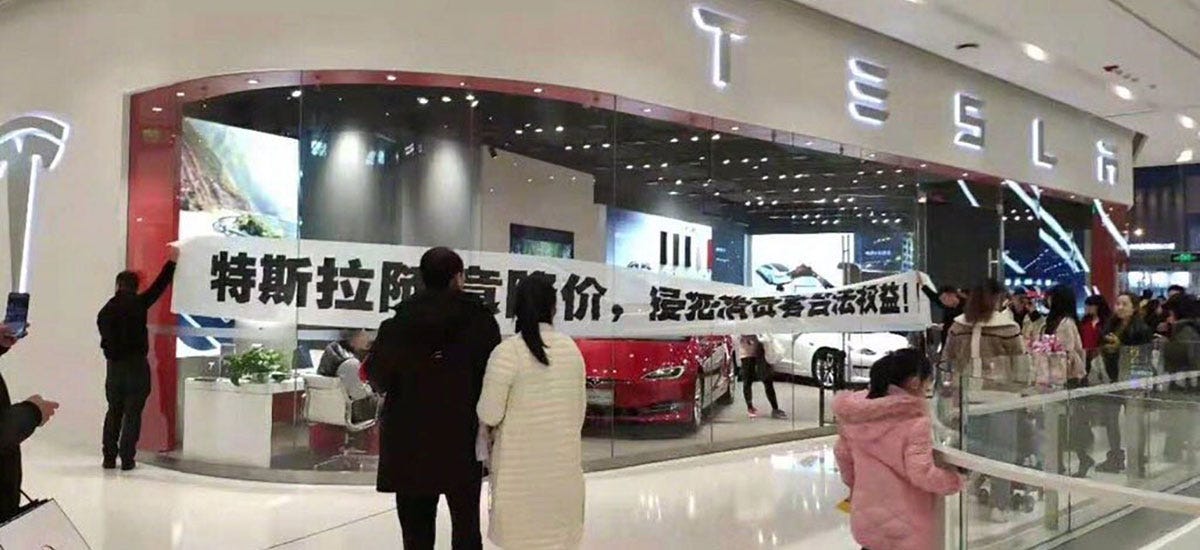What To Expect in Tesla’s Critical Q3
Tesla will report third quarter revenue and earnings this week which likely mask far weaker underlying core performance. Best to read between the lines and listen for what isn't said.
Tesla Motors (TSLA US) will report third quarter results after the market closes Wednesday, October 21st.
Tesla recently reported third quarter deliveries up 43% versus last year, again thanks to incremental sales from market expansion which continue to offset sharply lower same-store sales I've been tracking since last year (as I last discussed in Things People Believe: Flat Earth, Faked Moon Landings, and Tesla $2100 on 8/23/20).
That distinction is a major reason Tesla goes to so much trouble to keep comparable numbers muddled so demand erosion is harder to spot. Severe price cuts and weaker mix over the past year also mean revenue growth from auto sales significantly trails reported deliveries.
This will figure heavily into how much padding Tesla will likely add with energy credit sales, nonoperating & unusual items, and accounting maneuvers to inflate consolidated revenue and "profits" it reports for the quarter.
After all, another creatively reported profit could set up another $3 billion payday for CEO Elon Musk and finally get Tesla into the S&P 500 (SPX INDEX).
About Those Deliveries
Tesla reported 139,300 deliveries (up 43%) for the third quarter, which ended with September.
That fell within the range of reduced market consensus projecting 135,000-140,000 and my estimate of 135,643, forecasts which had nudged higher in recent weeks mostly on stronger than expected trends noted in Europe and China.
Deliveries also fell well below 160,400 Tesla had needed to average in the third and fourth quarter to meet the previous ambitious guidance by the company for 500,000 (up 37%) for the year, an outlook which still seems ambitious.
Fewer deliveries in the third quarter had indicated 182,000 (up 65%) must be delivered in the fourth quarter. That's well above my target of roughly 165,000 (up 49%) which indicates 482,820 (up 31%) for the year.
About Tesla’s “Insane” Demand
Tesla tempered its outlook on Battery Day, September 22nd, when Elon Musk projected deliveries up 30-40% for the year, which implies 477,750-514,500. This indicates 159,000-196,000 deliveries for the fourth quarter, up 44-77%, with the mid-point of guidance at 177,550 (up 61%).
The broad variance is no doubt contingent upon Model Y, Europe, and China, where sales trends in some areas surged by more than expected in the third quarter. However, recent signs suggest that strength could be faltering in the fourth quarter.
If so, this would confirm Tesla's continuing struggle to sustain comparable demand trends despite multiple rounds of aggressive price reductions and expensive sales incentives, as I have been tracking the past two years.
Models S & X deliveries, for example, have fallen every quarter in every market for two years. They fell 7% to just 8,177 in the third quarter versus last year when they plunged 44%.
US Model 3 deliveries fell another 46% versus last year when they dropped 14%, and now have been in double-digit decline in four of the last five quarters. Newcomer Model Y outsold Model 3 for the second-straight quarter by a widening margin, as I long forecast it would (I projected ever since Tesla: Into Thin Air on 1/15/20 that Model Y would cannibalize rather than augment sales of Model 3).
Tesla apparently also expected this since it immediately combined reported Models 3 & Y delivery numbers as soon as Model Y was launched near the end of the first quarter to mask Model 3's alarming deterioration.
Similarly, Model 3 sales have plummeted this year, as I expected, in Norway and The Netherlands, formerly Tesla's anchor markets in Europe. So, of course, Tesla stopped breaking out revenue from Norway and The Netherlands as of the first quarter this year.
Nevertheless, we can still see consolidated revenue excluding US and China fell 5% in the second quarter, which lapped the Model 3's introduction into Europe last year. Third quarter deliveries in Norway and The Netherlands fell by 55% and 77%, respectively, and are down ytd by 77% and 67%, respectively.
Meanwhile Tesla is losing ground in Europe to fierce competitors like Renault SA (RNO FP) Zoe, the new Volkswagen (VOW GR) ID.3, and Hyundai Motor Co (005380 KS) Kona. That's why Tesla has accelerated expansion of Model Y into Europe in early 2021 and will open the Berlin plant not long after—to create growth from incremental deliveries as same-store deliveries sag.
The same goes for the new Texas plant which will produce Model Y at scale next year plus likely nominal volume of the CyberTruck.
China deliveries are up substantially with the ramp-up of the Shanghai base, as expected. However, Made-In-China (MIC) Model 3 deliveries slipped to 11,329 in September versus 11,811 in August and 11,575 in July—all lower versus the peak of 15,023 in June.
Reports suggest monthly deliveries could decline to 10,000 or less as Chinese buyers are increasingly irritated with Tesla's multiple rounds of price cuts, poor quality and reliability of the cars, and that technology in MIC Model 3s lag US-made cars—as I warned in Tesla Q219 10-Q Notes and Big Red Flags on 7/31/19.
So it won't help that Tesla recently cut prices again, including on MIC Model 3, the 7th time this year for MIC Model 3s, at the same time it also dropped its generous 7-day return policy in all markets—including China. Which is why Tesla is accelerating Model Y production and delivery in China by the end of the fourth quarter as MIC Model 3 sales fade.
Another telling factor is that Tesla ended the third quarter with excess inventory in Models 3+Y and Models S+X. And no matter what excuse, or rather explanation Tesla offers, let's also observe that production capacity utilization was a tepid 63% which suggests that Tesla is far from overtaxed in supplying demand.
Third Quarter Finish
The trouble with Tesla for investors is not that it's growing sales, it's the persistent, nagging notion that it doesn't telling the truth about run-rate demand, sales, core profitability, or financial condition.
As a result, Tesla is perpetually pressured to keep the carousel going. Fading core demand trends are just the beginning. Eroding mix from multiple rounds of price cuts on all models in every market plus now nominal sales of expensive Models S & X dilute core revenue quality and squeeze margins every quarter.
That means Tesla has been driven to create ever larger revenue and profit enhancements—energy credits, deferred revenue, unusual items, convenient reserves adjustments & other accounting maneuvers—to inflate reported results sufficiently to mask persistent core weakness. This pressure has become so acute that Tesla is stretched to compensate for unfavorably comparable results coming now in just two-three quarters.
This means the largest adjustments yet are likely for the third quarter. I estimate third-quarter reported revenue at $8.26 billion (up 31% y/y), EBITDA near $1.3 billion (15.3% margin), and a net profit near $120 million (down 18%) versus the $143 million reported profit last year. I assume revenue, EBITDA, and profit were boosted by $500-600 million in energy credits and other unusual items which masked a loss of $420 million.
If so, I estimate full year reported revenue at $29.8 billion (up 21%) with EBITDA at $4.9 billion(16.3% margin) and $583 million in net profit versus the $862 million loss last year—boosted by $2.03 billion in energy credits and unusual items which masked an unvarnished $1.45 billion loss. With debt and leases also likely higher, as happens every quarter, leverage on core EBITDA is indicated at a hefty 7.1x.
As usual, we'll have to wait for the 10-Q to get a better picture of all the enhancements Tesla used to create reported results which continue to obscure far weaker core operating performance, financial condition, and credit quality.
I don't expect the exuberant stock market to be concerned about such salient details, but Tesla’s bond investors have remained more skeptical—for good reason.
Tesla's bonds are essentially unchanged since February at 103.8 (3.7% ytw; 333 bps), about where they were trading as of my last report. Compare that to the volatile stock price which is up 137% to $430 over the same period, indicating an EV multiple 85x my estimated 2020 reported EBITDA. Nevertheless, the paltry yield is169 bps tighter versus the BoA High Yield general index even though Tesla is a Caa1/B- issuer. Pricing also indicates a meager 92 bps per turn of leverage on my estimated 2020 reported EBITDA and an appallingly low 47 bps per turn of leverage on core operating—unvarnished—EBITDA. Such levels offer nominal upside reward at best and zero margin for disappointment. Maintain "Underperform."
Contact Us:
Disclaimer
This publication is prepared by Bond Angle LLC and is distributed solely to authorized recipients and clients of Bond Angle for their general use. In addition:
I/We have no position(s) in any of the securities referenced in this publication.
Views expressed in this publication accurately reflects my/our personal opinion(s) about the referenced securities and issuers and/or other subject matter as appropriate.
This publication does not contain and is not based on any non-public, material information.
To the best of my/our knowledge, the views expressed in this publication comply with applicable law in the country from which it is posted.
I/We have not been commissioned to write this publication or hold any specific opinion on the securities referenced therein.
Bond Angle does not do business with companies covered in its
publications, and nothing in this publication should be construed as a solicitation to buy or sell any security or product.Bond Angle accepts no liability whatsoever for any direct, indirect, consequential or other loss arising from any use of this publication and/or further communication in relation to this document.







